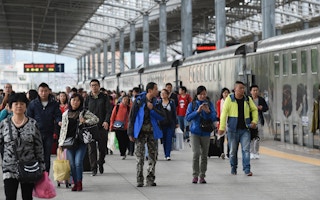As the global movers and shakers head to Davos this week, the consensus is that globalization is under threat as never before.
The President–Elect of the USA shows every sign of adopting “deal-based” transactional relationships based on narrow interests. As a result, we may find that in 2017 China emerges as the global leader on both maintaining globalization as a pathway for the world’s economies as well as a leader in climate and sustainability.
Commentators are concerned that China’s growth is slowing but it is still likely to top 6 per cent in 2017 – way ahead of other OECD countries. China is now the largest trading partner for some 120 countries and approximately half the world’s population.
It is already the largest export market for over 70 countries, with over $1trillion-worth of imports. It is expected to be a larger export market than the EU by 2020. In achieving this progress it has made enormous strides internally. Over 600 million people have been lifted out of poverty over the past 30 years and China has added some 100 million to its middle classes.
All this has been achieved, at least in part, because of globalization. But China has played the globalization game very differently to the west, adopting the rules that suit and playing the rest of the game to a strongly national agenda.
China has grown employment and protected it through state ownership of enterprises – anathema to the neoliberal consensus in the west. While communities in USA and Britain look at the jobs lost thanks to globalization, in China workers have done relatively well from it.
Wages at the lower end of the spectrum are proportionally higher than is to be found in other emerging economies. China has controlled the capital flows within the economy unlike the free movement of capital we see in Europe and the USA.
Not only that, China has continued to use state subsidies to support key industries leading to accusations of dumping as we have seen in the steel sector. Over the past 20 years, international businesses have flooded in to invest in establishing themselves in China and contributed to this progress, but all along China has insisted on local content to optimize benefits to its own people.
China has been both a driver of globalization, and a beneficiary from it by rigorously adhering to its statist capitalist model. As we look to the future of globalization, three other trends related to China stand out.
The first is increased authoritarianism and control. Civil society groups and NGOs have never been especially well developed in China and there is little prospect of that changing as the Communist Party cracks down on any non-party approved activity.
International NGOs and how they conduct their operations in country continues to be highly restricted. China has led the way in a wave of tighter rules and regulations on NGOs rendering redundant even the most benign of activism.
At the top, Xi Jinping has tightened his control of the Party becoming “core leader” in 2016, a largely titular but highly symbolic role in addition to Secretary General of the Party and President.
“
While China presents risks it also has much to offer in the transition to a sustainable globalized economy.
Towards the end of 2017 the five-year Party Congress will elect an entirely new raft of ministers and officials and we can expect his grip to tighten still further as a result. In short, the leader is probably more powerful than in any in a generation. That is not a value judgment but it provides space for Xi Jinping to be more active globally.
The second and third trends might be seen as positive. First, China’s approach to climate change and sustainability is ramping up fast. The western media understandably and rightly highlights the sustainability challenges of dreadful air quality, traffic chaos, resource crises and natural disasters.
Perhaps these events lie behind some of China’s recent moves, the latest being the commitment to invest fully $361bn in renewables by 2020. China has led the way in green finance with the People’s Bank of China being a lead player in the 2016 Year of Green Finance initiative.
Reporting of environmental risk is now mandatory and of course China made ambitious pledges to peak emissions by 2030 or sooner and cut carbon intensity rapidly.
The third trend is that China’s “One Belt One Road” strategy is not only alive and well, it is strengthening. As a result, we can expect to see China’s influence increase in economic terms but also in terms of sustainability issues.
China is seeking to take its seat in the global conversation in a stronger way than ever before. Xi Jinping will be a strong presence in Davos for the first time, giving an opening address today accompanied by a major delegation.
China was a major supporter of Antonio Guterres’s campaign as Secretary General of the United Nations and China is showing signs of much greater engagement in the UN just as President-Elect Trump is questioning the USA’s commitment to the UN and NATO.
As we look ahead and see concerns, risks and threats we should be open to the possibility that some of the solutions just might be emerging from unlikely places. While China presents risks it also has much to offer in the transition to a sustainable globalized economy.
Rob Cameron Rob is Chief Executive Officer at SustainAbility in London. This post is republished from the SustainAbility blog.









